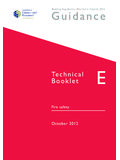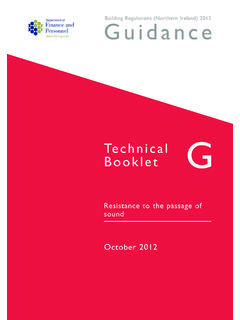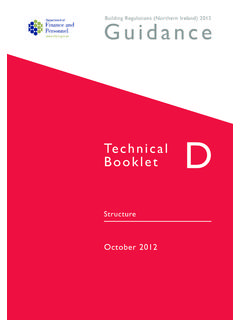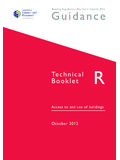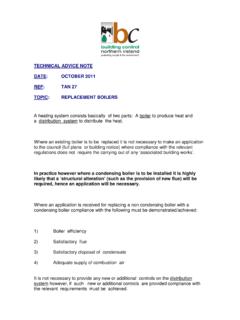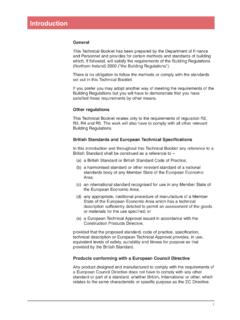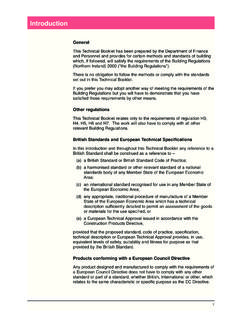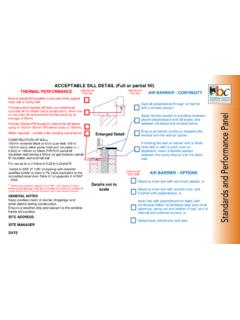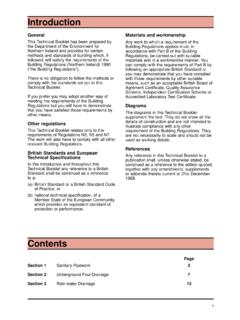Transcription of Technical Booklet - Building Control NI
1 Guidance Department of Building Regulations (Northern Ireland) 2012. Finance and Personnel Te c h n i c a l Booklet H. Stairs, ramps, guarding and protection from impact October 2012. Contents page Introduction Technical Booklets 3. This Technical Booklet 3. Protected buildings 4. Other legislation 4. Part H Regulations 6. Guidance Performance and introduction to provisions Stairs, ladders, ramps and their landings 9. Guarding 10. Vehicle loading bays 10. Protection against impact from and trapping by doors 11. Protection from collision with open windows, skylights or ventilators 11. Section 1 General Definitions 12. Visual contrast 13. Section 2 Access routes to buildings General 14. Ramps and complementary steps on access routes to buildings other than dwellings 15. Ramped approach 15. Ramped approach with complementary steps 15. Ramps and steps on access routes to dwellings 19. Section 3 Stairs Common provisions for all stairs 21.
2 Additional provisions for private stairs and common stairs in blocks of dwellings 25. Additional provisions for stairs in buildings other than dwellings 30. Spiral or helical stairs in dwellings 33. Technical Booklet H: 2012 Stairs, ramps, guarding and protection from impact 1. Stairs and fixed ladders providing access for maintenance 33. Section 4 Ramps in buildings Ramps in dwellings 34. Ramps within common areas of a block of dwellings 35. Ramps in buildings other than dwellings 36. Section 5 Guarding General 39. Guarding of spiral or helical stairs in a dwelling 41. Stair or fixed ladders 41. Vehicle barriers 41. Section 6 Vehicle loading bays Loading bays 42. Section 7 Protection against impact from and trapping by doors Doors and gates 43. Section 8 Protection from collision with open windows, skylights or ventilators General 44. Appendix Publications referred to 45. 2 Stairs, ramps, guarding and protection from impact Technical Booklet H: 2012.
3 Introduction Technical Booklets This Technical Booklet , which takes effect on 31st October 2012, is one of a series that has been prepared by the Department of Finance and Personnel (the Department) for the purpose of providing practical guidance with respect to the Technical requirements of the Building Regulations (Northern Ireland) 2012 (the Building Regulations). At the back of each Technical Booklet is a list of all the Technical Booklets that have been prepared and published by the Department for this purpose. The guidance given in a Technical Booklet includes performance standards and design provisions relating to compliance with specific aspects of the Building Regulations for the more common Building situations. If the guidance in a Technical Booklet is followed there will be a presumption of compliance with the requirements of those Building Regulations covered by that guidance. However, this presumption can be overturned, so simply following the guidance does not guarantee compliance.
4 For example, if a particular circumstance is not one of the more common Building situations the design provisions given in the Technical Booklet may not be appropriate. There are likely to be alternative ways of demonstrating compliance with the relevant requirements of the Building Regulations other than by following a design provision given in a Technical Booklet . There is therefore no obligation to adopt any particular provision set out in a Technical Booklet , should you decide to comply in some other way. However, you will have to demonstrate that your alternative solution meets the relevant requirements of the Building Regulations by those other means. This Technical Booklet Requirements The guidance contained in this Technical Booklet relates only to the requirements of regulations 56, 57, 58, 59 and 60. The work will also have to comply with all other relevant requirements of the Building Regulations. Materials and workmanship Any Building work which is subject to requirements imposed by Part A of the Building Regulations should be carried out in accordance with regulation 23.
5 Of those regulations. Guidance on meeting these requirements for materials and workmanship is given in Technical Booklet B which supports Part B. Technical Booklet H: 2012 Stairs, ramps, guarding and protection from impact 3. The Building Regulations are made for specific purposes, primarily securing the health, safety, welfare and convenience of people and for the conservation of fuel and power. Standards and Technical approvals are relevant guidance to the extent that they relate to these purposes. However, they may also address other aspects of performance such as serviceability, or aspects which although they relate to health and safety are not covered by the Building Regulations. Named standards Where this Technical Booklet makes reference to a named standard, the relevant version of the standard is the one listed in the Appendix. However, if this version has been replaced or updated by the issuing standards body, the new version may be used as a source of guidance provided that it continues to address the relevant requirements of the Building Regulations.
6 Diagrams The diagrams in this Technical Booklet supplement the text. They do not show all the details of construction and are not intended to illustrate compliance with any other requirement of the Building Regulations. They are not necessarily to scale and should not be used as working details. Protected buildings District councils have a duty to take account of the desirability to preserve the character of protected buildings when carrying out their functions under Building Regulations. Therefore, where work is to be carried out to a protected Building to comply with Part H or any other Part of the Building Regulations, special consideration may be given to the extent of such work for compliance where it would unacceptably alter the character or appearance of the Building . Protected buildings are defined in Article 3A(2). of the Building Regulations (Northern Ireland) Order 1979 (as amended). Other legislation The provisions of this Technical Booklet relate to the requirements of Building Regulations and do not include measures which may be necessary to meet the requirements of other legislation.
7 Such other legislation may operate during the design or construction stages or when a Building is brought into use and can extend to cover aspects which are outside the scope of the Building Regulations. The Workplace (Health, Safety and Welfare) Regulations (Northern Ireland) 1993. The Workplace (Health, Safety and Welfare) Regulations (Northern Ireland). 1993 (the Workplace Regulations) contain some requirements which affect Building design. The main requirements are now covered by the Building Regulations, but for further information see The Workplace Regulations and the Workplace Health, Safety and Welfare Approved Code of Practice and Guidance published by TSO. 4 Stairs, ramps, guarding and protection from impact Technical Booklet H: 2012. The Workplace Regulations apply to the common parts of flats and similar buildings if people such as cleaners, wardens and caretakers are employed to work in these common parts. Where the requirements of the Building Regulations that are covered by Part H do not apply to dwellings, the provisions may still be required in the situations described above in order to satisfy the Workplace Regulations.
8 Technical Booklet H: 2012 Stairs, ramps, guarding and protection from impact 5. Part H Regulations Part H (comprising regulations 54 to 60) of the Building Regulations, which sets out the requirements for stairs, ramps, guarding and protection from impact, has been replicated for the convenience of the user of this Technical Booklet and is taken directly from the Building Regulations (Northern Ireland) 2012. Any person who intends to demonstrate compliance with the Building Regulations by following the guidance given in this Technical Booklet is advised to ensure that the regulations below, are current on the date when plans are deposited or notices given to the district council. As Part A (comprising regulations 1 to 21) of the Building Regulations sets out the interpretation along with the procedural requirements relating to the application of the regulations, the Department advises that all Parts of the Building Regulations are read in conjunction with Part A of those regulations.
9 The Building Regulations (Northern Ireland) 2012 and any subsequent amendment/s may be viewed by following the links from the Department's website at . PART H. Stairs, ramps, guarding and protection from impact Application and interpretation 54. (1) Subject to paragraphs (2) to (6), this Part shall apply to any Building or part of a Building . (2) The requirements of regulation 56 shall only apply where a stair, ladder or a ramp and landings . (a) forms part of the Building ;. (b) that does not form part of the Building , is provided to comply with the requirements of Part E or Part R; or (c) provides access to an entrance or exit of the Building and the general ground level immediately outside that entrance or exit. (3) The requirements of regulation 57(1) shall not apply . (a) to the extent that compliance therewith would unreasonably obstruct normal movement to, into, out of or within any Building ;. (b) in relation to the two steps at the bottom of a stair where the landing from which the stair rises does not require guarding in accordance with that paragraph.
10 (c) in relation to a flight within a stair with a total rise of less than 600 mm;. (d) in relation to a sunken area less than 600 mm in depth; and (e) in relation to a roof or other place to which access is solely for maintenance purposes provided that either . (i) access is infrequent; or (ii) any fall would be . (aa) less than 2000 mm; or (bb) to an area which does not present a hazard. 6 Stairs, ramps, guarding and protection from impact Technical Booklet H: 2012. (4) The requirements of regulation 57(2) shall not apply in relation to a car showroom, a garage within the boundary of a dwelling, or a single storey Building comprising two or more garages each of which has an area not exceeding 40 m2. (5) The requirements of regulation 59 shall not apply to . (a) a dwelling; and (b) a door or gate which is part of a lift. (6) Insofar as they relate to a dwelling, the requirements of regulation 60 shall only apply to a window, skylight or ventilator which opens over a public route of travel.
